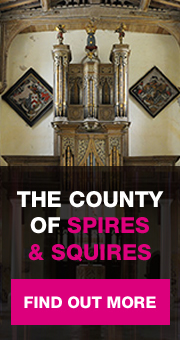Of early medieval origin but almost entirely rebuilt during 15th century and an especially fine example of Perpendicular architecture, most notably its splendid lantern tower.
From the former church is a display of early 14th century stained glass, amongst the finest in the Midlands.
The tombs in the church lie in two distinct areas, in a chapel on the south side and another to the north of the high altar.
All the tombs are to the owners of Drayton, beginning with the Greenes, then the Mordaunts, then the Germaines and finally the Sackvilles.
The only exception to this is that of the Earl of Wiltshire, but he was the main Greene heir in the late 15th century. In chronological order Ralph Greene and his wife Katherine Mallory. This has recently been transported to London and back as it was included in the V&A gothic exhibition. It is by Thomas Pentys and Robert Sutton of Chellaston in Derbyshire and when it was delivered in 1420, three years after Ralph Greene’s death, it cost £40, no mean sum. It is a sumptuous altar tomb and was originally topped by an arched framework, the stumps of which can be seen. The other changes of course, the disappearance of the painting and gilding which would have covered its surface. Like a number of Nottingham alabaster tombs Sir Ralph and his wife are touchingly holding hands. Henry Greene and his wife, Margaret. This is a tomb chest, topped not with recumbent figures but with an engraved brass. This too would have been coloured originally with enamels set in and parts gilded of which there are still traces. His enamelled heraldic tabard must have been spectacular. Don’t miss his flowing locks!
Nearby stands the tomb of Sir Edward Stafford, 2nd Earl of Wiltshire, (1470 - 1499). As a young man he bore the Queen’s crown at the Coronation of Richard III but he managed to adroitly change tack and entertained Henry VII at Drayton in 1498.
The chapel on the south side is the Chantry Chapel set up following his early death. He lies in Nottingham alabaster on his chest, tomb with charming bedesmen with their rosaries perching on the muzzled bear’s back, beneath the soles of his feet remind one that this was a chapel where Masses for his soul would have been said till the Reformation.
Originally coloured and gilded, perhaps even his flowing locks! To the side of the chest are his armorials alternating with the Stafford knot. In the chapel beside the altar are further tombs to Lord William Mordaunt, (d.1625) a curious architectural composition.
He was the infant son of the 1st Earl of Peterborough. It looks like a doorcase, and is set with a most beautiful piece of stone. It would be interesting to know what this is. Nearby the great tomb of Lady Mary Mordaunt, Duchess of Norfolk, and after her divorce Lady Germaine, although she seems to have kept her ducal title (1658-1705).
She inherited Drayton from her father, the 2nd Earl of Peterborough and carried out the great improvements there to the design of Talman. She left the Duke of Norfolk for William II’s possible half brother, Sir John Germaine, who is commemorated alongside. Her tomb, which is attributed to William Woodman of London (1654-1731) shows her resting on a cushion with a skull beneath it. Rather surprisingly, given her life, she holds a martyr’s palm, note the equally surprising bare feet.
Woodman provided marble decoration for Drayton during her lifetime. If you care to stretch, there are two interesting panels to either side. One a landscape with skulls and cherubs rising into the sky, the other a vanitas still life – you will need a torch.
Her second husband, Sir John’s tomb, was raised by his redoubtable second wife, Lady Elizabeth Berkeley, daughter of Charles, Earl of Berkeley of Cranford, an estate now lost under the runways of Heathrow.
He is shown as a military figure in armour and holding an almost medieval helmet. Beneath is a slab memorial to his three children by his second marriage, who predeceased him.
He died in 1718 and this great monument is attributed to Edward Stanton of Holborn in London. His wife, who lived until 1769 ruling and improving Drayton, is only commemorated by the finely engraved coffin brass on the adjacent wall.
The final tomb of note in the south chapel is to Charles Sackville, 5th Duke of Dorset (1766-1843). By Westmacott junior, signed on the marble book, this is a wonderfully theatrical tomb in a vaguely gothic style with a recording angel to the right and the ducal robes and painted armorial shield to the left. Just so that there can be no doubt as to the grandeur of the invisible figure who is commemorated here, his ducal cushion, resplendent with its strawberry leaves, sits on the cushion beneath.
Please refer to the Glossary for any terms in the text that you are unfamiliar with.







